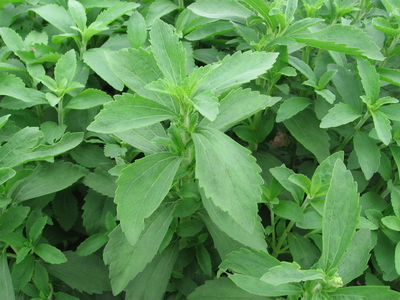
Food Safety Focus (46th Issue, May 2010) – Food Safety Platform
Steviol Glycosides –Sugar Substitutes from Herb
Reported by Ms. Janny MA and Ms. Melva Chen, Scientific Officers,
Risk Assessment Section, Centre for Food Safety
In the past issue, we have savoured a powerful sugar substitute called neotame. Do you prefer something natural? Then you should not miss the one in this issue - steviol glycosides. Just like sugar, they are naturally occurring of plant origin.
Portfolio of Steviol Glycosides
-
Name ( INS number) : Steviol glycosides (960)
-
Source: Stevia plant ( Stevia rebaudiana Bertoni)
-
Compositions: Depends on the stevia leaves and the extraction and purification processes used; usually contains high percentage of stevioside and rebaudioside A and small amounts of other glycosides
-
Technological function: Sweetener
-
Sweetness intensity: ~200-300 times sweeter than table sugar
-
Energy value: ~0 kcal per gram
-
Applications: fruit products, pickles, desserts, confectioneries and table-top sweeteners
From Herb to Sweeteners
Stevia is native to South America. For hundreds of years, people in Brazil and Paraguay have used the leaves of stevia to sweeten teas and foods and have used it as herbal medicine for diabetes, obesity, hypertension, etc. Not until the 70s, the extracts, steviol glycosides, were first commercialised as a sweetener in Japan. Today, stevia is cultivated in many countries and China is the largest grower of stevia as well as exporter of steviol glycosides.

Stevia plant (Source: Zhuhai Stevia Science Development Co., Ltd.)
Taste of Steviol Glycosides
While "natural" is the strength of steviol glycosides,"taste"may be the weakness of this sweetener. Steviol glycosides in general have a slower onset and longer duration of sweetness than sugar. Furthermore, each steviol glycoside has different taste, for instance, stevioside has a slight herbal taste, rebaudioside-A has a clean sweet taste, and other minor steviol glycosides have bitter or licorice-like aftertaste. Some people find the lingering sweetness and bitter taste to be less desirable. The composition of the steviol glycoside mixtures may differ according to the cultivar from which the steviol glycosides are extracted, and differences in the manufacturing process.
Safety of Steviol Glycosides
Steviol glycosides are determined safe by both international and national food safety authorities based on the findings that they are of low toxicity and are not toxic to genes or cancer-causing. The Acceptable Daily Intake (ADI) for steviol glycosides is 0-4 mg/kg body weight. Since only small amount of sweeteners is used in foods, the ADI is unlikely to be exceeded upon normal consumption of foods containing steviol glycosides.
Regulation of Steviol Glycosides
Based on the favourable safety assessment results of steviol glycosides by food safety authorities, the international food standard-setting body, Codex, is currently drafting provisions for steviol glycoside for use as a sweetener. To date, steviol glycosides are permitted in many countries including Mainland China, Japan, Korea, the USA, Australia and New Zealand.
Local Situation
In 2002, a large-scale food recall took place in the territory because of the presence of stevioside, the principal sweetening compound of the steviol glycosides, in a variety of food. At that time, food safety authorities around the world have not yet come to a conclusion regarding the safety of stevioside. Now, in view of the latest scientific development, the safety of steviol glycosides has been assured. We will soon be able to enjoy food with these natural sweeteners as the local regulation will shortly be amended to include steviol glycosides as permitted sweeteners.
A Kind Reminder on Sweeteners
In the series of sweeteners, we have introduced to you neotame and steviol glycoside, along with the currently permitted sweeteners. A total of 10 sweeteners will be available in the near future. Although there is no safety concern on these sweeteners, there are "sweet-traps" to be aware of. People with diabetes or weight-watchers may opt for sweeteners. Removing sugar solely from a food does not automatically make it low-calorie or low-fat. Eating too much of these sweeteners-containing food may still lead to high blood sugar in diabetic patients due to other carbohydrates in the food or weight gain due to other ingredients such as fat. So, no matter the food is added with sugars or sweeteners, it is important to maintain a balanced diet.


